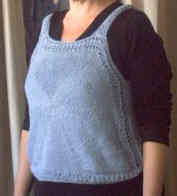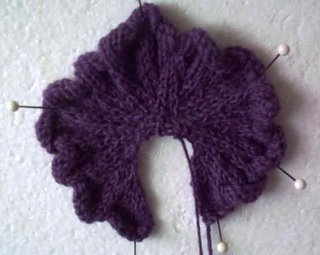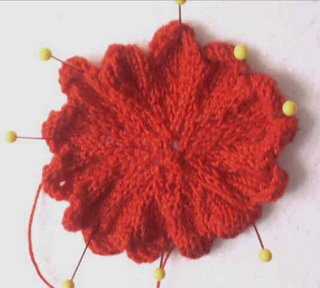Playing in the same areas
While I've been knitting flowers for the better part of 18 months or so, the appearence of Nicky Epstein's Knitted Flowers book in LYS means lots of people will assume that my flowers are from her book.
I hate it when that happens. I have this habit of playing in areas where other, more established, folks are also playing. Nicky's and my flowers are just one in a long series of such coincidences.
Great or not, some minds just think alike and play in the same areas. I've always been interested in alternate construction techniques, knitting as sculpture and turning mistakes to advantage.
I was playing with designing a child's sun dress with a swirl hexagon as the start of the top when the Summer 2002 IK came out -- and, as is often the case, I saw that another knitter/designer was playing in the same knitting sandbox as I was. In that case it was Norah Gaughan and her Sunburst Pullover (ditto her Mandalay Swirl) and, as I always do, I put my design efforts in that arena on hold, carefully avoided looking at those designs, and explored other design areas.
Early in 2005 I came back to idea and my medallion that morphed top was born.
For the child's sundress, I wasn't locked into either the geometric or the swirl hexagon and I didn't see a big problem in forming the increases with YO's. For an adult, the swirl, at least IMO can highlight figure elements in rather unfortunate ways and the YOs could be disaster waiting in the wings.
When the geometric's increases are bar (aka knit into front and back)increases the increase lines gave the illusion of bust darts.
It started out as a centre out geometric hexagon. When I reached the desired size, I used short rows to extend two of the bottom sides and form a trapezoid.
Then I knit a 2nd medallion just alike.
I did a bit of a redesign of the Roman Stripe lace knitting stitch pattern to give it a less directional feel and extended my trapezoids out a bit joining them under the arms with a three needle bind-off. I used the same lace in short panels for straps.
I worked it in a cotton linen blend and it does have a tendency to "cup" a bit at the bottom but in a more ameniable to blocking fabric, if that was a problem it could be eliminated. I don't believe the cupping is inherent in the design but probably a matter of my less than elastic bind off.
I say I knit one just alike as if it was that simple. Well, it wasn't -- I had second "side" syndrome and kept starting swirls when I should have been doing geomertrics or working geometrics but suddenly forgetting the works for me formula to get flat fabric.

Norah has a new book out called Knitting Nature. Knitpicks lets you view some of the inside pages from here. If you click on the view inside pages link and navigate to the last page
you'll see that Norah too seems to think that hexagons can become knitted tops. I like my experiments better.
Sticking to the sleeves -- a more flattering solution
Second side syndrome did have a strange side benefit. I was seeing a lot of halter tops in the shape of an inverted pentagon and my hummingbird of a neighbour got me thinking that a swirl pentagon wouldn't be a problem. So I started thinking that a pentagon might make for a very nice little Summer top and something that fades like denim would be perfect.
Denim yarn, like denim fabric tends to shrink more in length than in width. That fact combined with many knitter's fear of math and disinclination to swatch explains why denim yarns, while wonderful stuff scare many knitters off.
It occurred to me that a garment formed from medallions, with its knitting going in all directions, would not have the shrinks more in length problem of traditionally constructed garments. So I took up some needles and some Den-m-nit and swatched a medallion and a bottom to top piece. I outlined their shape/size on a piece of cardboard before laundering. When I compared the post laundered swatches, the medallion had shrunk in a more uniform manner than the bottom to top swatch.
While I was working on the pentagon swatch, at some point, I folded it in half and the shape reminded me of a raglan sleeve.

That got me thinking that garments formed from medallions would flatter more figures if you limited the use of morphing medallions to the sleeves rather than in the body of the garment. The design idea that was born had one sleeve with the pentagon at the bottom with its point pointing up and the other with pentagon at sleeve top with point pointing down.
I knew that short rows would be involved but I was a bit fuzzy on the details. I started in on the experiment with the denim yarn and in the first trial, I went too far with the short rows. I set it aside and started another version -- that one also had a less than ideal result. That's when I shifted from the denim to some Intermezzo in a cool minty green.
All three experiments sat on needles/waste yarn for nearly a year before I decided that I needed a break from flowers and some larger gauge knitting was in order. BTW, in my world, larger gauge is anything between a 2mm needle and about a 3.75mm needle. Everything over that starts the slippery slope to honking huge gauge.
I wasn't really thrilled with the 5 stitch icord start to my original sleeve/swatches so I consulted my polygon notes and cast on 10 stitches and followed the swirl directions. Even though I was on walkabout, I was paying attention so I know that I wasn't making the add an extra "rest" round before increases mistake that I'd made many times before. No, I was following the increase one round and rest one round formula but the fabric was far from flat.

So I pulled it off the needles and cast on again the next day, this time I increased every round like the instructions read for almost every other polygon -- flat fabric. Either this is one of those one offs with these needles, this yarn and me, or Mary Thomas is wrong -- horrors.
I played a bit with different wrapping short row methods but decided that the effort wasn't worth it for a bit of knitting that will be at the underarm -- indeed the resulting holes might help define the shape and make it look like a planned gusset.
Once again I took the short rowing a bit too far -- nice look but way too long a sleeve for me. So I frogged/tinked back and only filled in 1/2 of the stitches on each side. That was Friday and early Saturday's entertaining unknit fun.
As I was working on it, it occurred to me that the top of the medallion was increasingly disappearing into the sleeve top. My first thought was that I should have either done the medallion in a more textured stitch pattern and then switched to plain stocking stitch or vice versa. I'd considered that option before but thought it would be too busy -- maybe not.
As a second option, I thought that doing a single purl bump out on the final medallion row would define the medallion shape and be a nice subtle design element that could also deemphasize the holes from the short rows. I even said this out loud in the company of knitters who thought it a good idea.
Not liking the idea of still more ripped out rows, I decided to play the throw some lace in there to match holes with holes -- really obvious really soon that lace holes were much bigger than the short row holes -- so unknitting time again. Decorative make ones might have been a better solution also wouldn't have really defined the polygon's shape.
On Sunday sleeve (once again back to the end of the short rows) and I went walkabout.
My_for_this_time _around solution does involve purl stitches coming out from the short rowed segments. I may not have kept the best track of the symmetry and while this did produce a sleeve of the correct length for me, I think the texture change either subtle (the last round of medallion having a purl bump) or dramatic (texture stitch and stocking mix) would allow for more sleeve length adjustments for other sizes.
I finished the last purl meets purl row just as I was crossing 6th at Robinson and worked some icord for still more flowers on the last half mile home.

I'm not quite sure whether I'll make a second sleeve just like this one and leave the one pentagon pointing up and another pointing down for another project for another time. For the moment I'm just delighted that have successfully morphed a pentagon into a sleeve. Here's the unfolded sleeve.

Sometimes flat is better or round is not always right
So I'm still designing and knitting flowers even though the appearance of Nicky Epstein's Knitted Flowers book in LYS means that my class proposal is a moot point as people will be teaching from/based on the book and more than likely making the leap of logic that says my stuff must be based on hers -- pish. More on that later.
The poppy thing didn't quite pan out as expected and it is sort off in the corner perhaps waiting to inspire something else. At the moment I'm thinking clover -- 3 or 4 leaf but I could shift gears.
When I was still trying to put together class materials/proposal for the knitted flowers, I decided that maybe a knit flat option for the not so adventurous knitter (read dp challenged) should be part of the matrix so I did some playing.
While I know that any edging or stitch pattern that produces a shaped bottom edge (think the scallops of feather and fan/old shale or peri's parasol etc) can, with appropriate deceases form a great little blossom I wanted something really simple but innovative.
Shortly after Knitting on the Edge first came out, I popped into Knitting In La Jolla one day when LYSO Suzanne was not having much success making sense of Nicky's "stockinette stitch T twist" on page 153. I took a look and figured out that the problem was simply perspective, she wasn't reading is as a starting edge but as an ending edge - once that was cleared up the whole 360 degree counter clock rotation of the left needle makes a lot more sense.
 Since I needed some walkabout knitting, and this was sort of revisit the notion, I cast on 84 stitches with some cotton rug warp and was really just intending to revisit the 360 degree rotation.
Since I needed some walkabout knitting, and this was sort of revisit the notion, I cast on 84 stitches with some cotton rug warp and was really just intending to revisit the 360 degree rotation.
It was just supposed to be a swatch but it turned out pretty well so I wrote up a quick and dirty pattern and sort of left the making in a tbd fashion. In the snap, the cast on is at the bottom right and the cast off is to the centre middle. There are 14 6-stitch segments and it pinned out to keep the ruffle from happening.
I liked the result but wanted to see what would happen if I shirt tail short rowed the bottom before doing the 360 degree twist and I also wanted to play with working it in the round.
 So I cast on 84 stitches knit flat, did a little short row shirt tail thing, with fewer full rows before the twist and then after a couple of brain freezes, I joined, decreased and go this little number (also pinned off to stop the ruffle).
So I cast on 84 stitches knit flat, did a little short row shirt tail thing, with fewer full rows before the twist and then after a couple of brain freezes, I joined, decreased and go this little number (also pinned off to stop the ruffle).
As much as I like knitting in the round, the 360 degree rotation is not a good option without using a cable need or something to act in the place of an independent LH needle. Another thing that working flat offers is the whole a spiral thing which produces a dimensional flower without having to master dps -- a good option for the novice knitter. Pics below show the purple and the red unpinned out and you can see how the purple spirals in on itself for a good result.

 The purple can be made to behave like the knit in the round red but the in the round red will not spiral like the knit flat. And the spiral is a good thing so I'm going to play with short row shirt tailing the knit flat and also with varying the number of stitches between twists to see whether what I think will happen does.
The purple can be made to behave like the knit in the round red but the in the round red will not spiral like the knit flat. And the spiral is a good thing so I'm going to play with short row shirt tailing the knit flat and also with varying the number of stitches between twists to see whether what I think will happen does.











